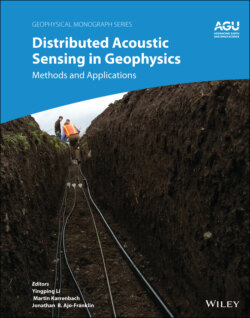Читать книгу Distributed Acoustic Sensing in Geophysics - Группа авторов - Страница 24
1.2.1. DAS Optimization for Seismic Applications
ОглавлениеDistributed fiber sensors measure physical parameters of an external environment continuously through the integration properties of light traveling along a lengthy optical path. This is quite different from point sensors, such as geophones, which make an inertial measurement of ground speed at fixed positions (SEAFOM, 2018). The DAS records a local strain rate, which can be converted into particle velocity to allow direct comparison with geophone data. Following Jousset et al. (2018), we can approximately represent DAS signal A(z, t) via ground displacement u(z, t), where FS is the DAS sampling frequency and L0 is the gauge length.
If FS → ∞, L0 → 0, then the DAS signal can be presented in a double differential form:
These simplified expressions (Equations 1.23–1.24) give us a qualitative sense of the DAS algorithm output. For a subsequent quantitative analysis, we shall need the detailed expression that was obtained in the previous section. Namely, for a nonzero interferometer gauge length L0 and optical pulsewidth τ, averaged over random scattering DAS output, A(z) can be represented by Equation 1.15 in expanded form:
where FS is sampling frequency and A0 = 115nm is a scale constant (Equation 1.14). So, the velocity field can be recovered by spatial integration starting from a motionless point as:
Then DAS signal (Equation 1.25) can be transformed using shift invariant a(z1) ⊗ b(z1 + z2) = a(z1 + z2) ⊗ b(z1) to:
where θ(z) is the Heaviside step function, whose value is zero for a negative argument. As expected, the DAS signal is represented (Equation 1.5) as a convolution of a point spread function with v(z).
Spatially integrated signal (Equation 1.27) was modeled for 10 m gauge length and 50 ns pulsewidth, as shown in Figure 1.5 (right panel). The results of modeling (Equation 1.25) are presented in Figure 1.11 (left panel), and the result is converted to geophone‐style data (Equation 1.26) in the right panel. From a practical point of view, low temporal frequencies, out of the range of interest, can be filtered out, and also spatial antialiasing filtering can be used. It is worth mentioning that the right panel of Figure 1.11 demonstrates the real change in polarity of the reflected seismic pulse. Also, spatial integration (Equation 1.26) acts as statistical averaging, which eliminates the randomness of the “staircasing” in Figure 1.5 left panel.
The most valuable geophysical information is delivered by sound waves with frequencies below FMAX = 150Hz, as higher frequencies are attenuated by the ground. For a speed of soundC = 3000m/s, this corresponds to an acoustic wavelength C/FMAX = 20m, so Nyquist’s limit dictates that LG ≤ C/2FMAX = 10m is the maximum spacing of conventional sensors. Formally, the linear spline approximation G(z) of conventional antenna velocity v(z) output can be represented using expressions from (Unser, 1999), as:
(1.28)
The spatial spectral response of DAS in acoustic angular wavenumber Kz can be represented by Fourier transform ℑ(Kz) following Goodman (2005):
Such spectral responses can be normalized for a constant signal ℑ(K) = 1 (see black line in Figure 1.12). The comb function in (Equation 1.29) is responsible for the repeating of the spatial spectrum with a shift of 2π/Λ, as is shown by the dotted line. To prevent aliasing, the signal spectrum should be inside Nyquist’s limit, which is shown by the gray vertical line.
Let us compare the conventional velocity sensor with the DAS spectrum, calculated from the spatial resolution expression (Equation 1.25), by Fourier transform as:
Two cases are presented in Figure 1.12: when the optical pulse length is almost equal to the interferometer gauge length τ = L0, and when it is half the interferometer gauge length τ = L0/2 (see dashed and solid blue lines, respectively). The absolute value is presented in the figure to aid comparison between curves. In the second case, we have a gain, which is highlighted by the blue filling. This gain can be explained by signal smearing over a long pulse.
Figure 1.11 Acoustic measurements using DAS: The left panel represents strain rate measurement and the right panel displays ground speed measurement, the transform to which comprises filtering and integration. The signals’ cross‐section along the white line is shown in the bottom panels in radians. The modeled source is shown in the right panel of Figure 1.5.
Figure 1.12 Comparison of DAS spectral response with that from a 10 m sensor antenna array.
It seems from Figure 1.12 that DAS low frequency sensitivity is significantly lower than that of a geophone. Practically, however, this is not the case, as the geophone noise rises at low frequencies, and this can be characterized by some high‐pass (HP) filters that limit the range to frequencies around 10 Hz (see dotted line in Figure 1.13). However, DAS has the potential to increase the spectral response at low frequencies by increasing interferometer length—for example, from L0 = 10m to L0 = 30m (see Figure 1.13). So, potentially, the DAS response can be synthesized from two measurements: with a short interferometer gauge length to deliver high spatial frequency bandwidth, and a long one to deliver low frequency. As the result, full‐frequency coverage can be as good as from a geophone antenna, or possibly even better, as will be shown in a later SNR comparison. An additional advantage over geophones is the large dynamic range of DAS at low frequencies, which will be discussed later.
Figure 1.13 Low spatial frequency gain in DAS by using long interferometer.
